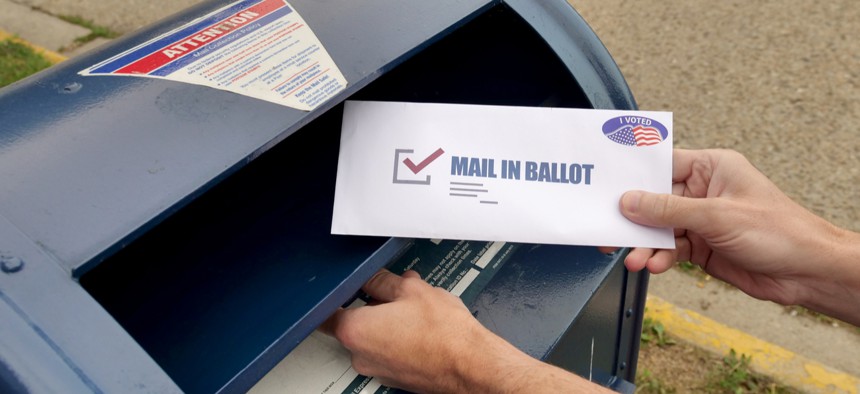
Orlowski Designs LLC / Shutterstock
Viewpoint: The Postal Service Will Deliver on Mail-In Voting
The election outcome will impact the policy path the Postal Service will follow in the years to come, argues a former chairman of the Postal Regulatory Commission.
As Election Day approaches, the U.S. Postal Service is under increasing pressure. Compounding the agency’s woes of declining mail volume, high expenses, and mounting debt and liabilities, now American election results may hinge on its ability to deliver a huge surge of mail-in ballots during a global health pandemic. The election outcomes will determine not only our new political leaders, but also impact the policy path that the Postal Service will follow in the years to come.
For the past several election cycles, early voting in person and voting by mail have been offered in an effort to make voting more accessible and democratic. Voting is fundamental to our democracy, which is why the National Academy of Public Administration named Protect Electoral Integrity and Enhance Voter Participation as one of the 12 Grand Challenges in Public Administration.
Some states, like Oregon and Washington, have relied on voting by mail for years. But this election, the COVID-19 pandemic is forcing large groups of voters across the country to cast their ballots by mail for the first time. While the real challenges lay at the local level where election officials will be charged with tabulating these votes, the increase in mail volume will stress test the Postal Service’s capacity to deliver the ballots in an accurate and timely fashion.
The vast majority of these mail-in ballots will be processed and delivered locally. They will be processed as first-class mail and voters can be reasonably confident that their ballots will arrive at their local election offices in a timely manner, especially if cast early. Even if ballots face a minor delay in reaching their local destinations, voters should be reasonably assured their ballots will be delivered within a week or so of putting them in the mailbox. However, voters who wait until the last minute to cast their ballots may see longer than normal mail delays, putting their votes in jeopardy of being thrown out, depending on state election laws.
Relying on the Postal Service to serve as the nation’s trusted carrier in times of emergency underscores the importance of this public institution. It has long been one of the federal government’s most trusted agencies, made up of proud public servants who are in daily contact with communities across the country. The institution, however, faces serious threats that undermine its long-term viability. Reports concerning delayed and discarded mail further cast doubt on the ability of the Postal Service to perform its mission.
Post-election, the Postal Service will have sufficient cash and borrowing authority to ensure reasonable levels of service in the short term, but the long-term prognosis is not as rosy. In 2021, the next administration will have the opportunity to fill three empty seats on the Postal Service Board of Governors and decide whether to retain or change the leadership at the Postal Regulatory Commission.
Importantly, those new governors may tip the balance in determining the fate of the current Postmaster General and the direction of future Postal Service transformation efforts. Congress will determine whether to grant the Postal Service pandemic relief or other funding. The Treasury Secretary will play a critical role in determining how any federal dollars directed to the Postal Service by Congress will be accessed and on what grounds.
Looking forward, Postal Service leaders, the administration, Congress, stakeholders and the public must engage in a national conversation about our country’s expectations for postal services. The Postal Service is a government agency with a critical public service mission, yet we ask it to operate like a business. Are these directives compatible? Can they be reconciled, and how? What does universal service mean in the digital age when many, but not all, Americans can send mail with the click of a button on their computer? Should we continue 6-day-a-week delivery directly to all households, or are there alternative ways of delivering? Do we want more privatization within the Postal Service? What about the requirement to pre-fund retiree benefits? To meet the public’s expectations, how do we fund it to ensure long-term viability?
These questions will be important ones for the next administration and Congress to answer. As a voter, you can weigh in on how our elected leaders address these questions. To do so, you must vote. Mail your ballot as soon as you can. Follow the instructions accompanying your ballot. And know that the Postal Service, despite its long-term financial challenges and recent operational changes, will deliver your ballot to its appointed destination to ensure that your voice can be officially heard.
Mr. Blair is the former Chairman of the Postal Regulatory Commission. He is also former Acting Director and Deputy Director of the Office of Personnel Management and former President and CEO of the National Academy of Public Administration.






